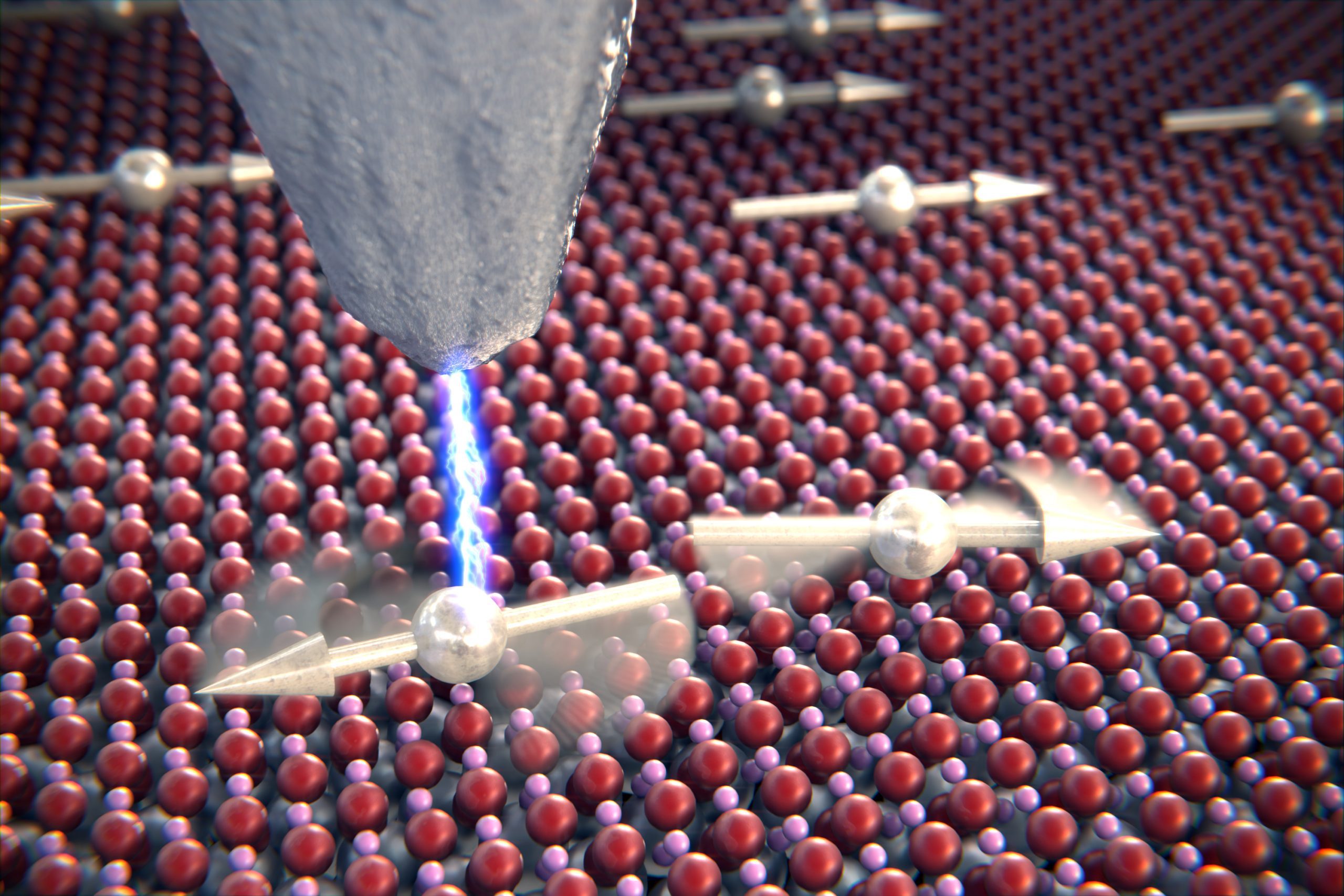Electrical conduction and magnetism are caused by the group behaviour of atoms. TU Delft researchers used an experiment to demonstrate how atoms interact.
An electrical current from the microscope's tip jolts the magnetic spin of an atom, influencing the neighbour. (Artist impression TU Delft)
Material properties such as electrical conduction, magnetism and superconductivity (electrical conduction without resistance) are the result of how atoms interact. Compare it to a choir: one man can sing nicely, but put a hundred singers (M/F) together and suddenly you hear Giuseppe Verdi’s enchanting Slaves Chorus.
How macroscopic material properties arise from atomic interactions is a fundamental question in physics. Prof. Sander Otte’s (AS) research group lifted the tip of the veil in a remarkable experiment. It earned them an article in the authoritative journal Science.
For the experiment, PhD student Lukas Veldman, lead author of the Science article, worked with a tunnel microscope. No other instrument has such a sharp tip that it can hit a single atom. Using the tip of the microscope, Veldman sent a current through a titanium atom and upset the magnetic spin.
Up and down
A magnetic spin has two polarities: up or down. A pulse of current changes the polarity of the spin, but after a while it falls back. Not very exciting, then. But put another titanium atom nearby, about eight atom diameters away, and the researchers saw the following pattern occur: up, down, up, up and so on.
It was the first time that interaction between atoms had been demonstrated so directly
An isolated atom spin shows a slow decay, but with another atom nearby, the atom spin vibrates. The smaller the distance, the greater the influence and the higher the frequency.
It was the first time that interaction between atoms had been demonstrated so directly, which is why the researchers were able to publish their results in Science. For this research, the group of Prof. Sander Otte, Veldman’s supervisor, cooperated with RWTH Aachen University and the Research Center Jülich.
“The interaction between atoms proceeds according to the laws of quantum mechanics,” Otte explains over the phone. “It only gets really interesting with three atoms or more. The number of possible quantum states increases exponentially and becomes impossible to calculate in a system with hundreds of atoms.”
Two-way approach
Yet Otte knows that material properties, such as the much-coveted superconductivity (electrical conduction with zero resistance), are the result of the ensemble of interactions between atoms. The question is, can the gap between quantum behaviour and material properties ever be bridged?
Otte has pinned his hopes on a two-way approach. Colleagues study superconductivity with a tunnel microscope in ever smaller pieces of material: the so-called top-down approach. At the same time, Otte and his group are working on the bottom-up approach. They have started with the interaction between two atoms, and are now expanding to three, four, and eventually dozens of atoms. It is a logical assumption that they will run into each other at some point.
Creating matter atom by atom is research motto of the Sander Otte Lab. Two years ago, he received a NWO Vici grant (in Dutch).
- Lukas M. Veldman, Laëtitia Farinacci, Rasa Rejali, Rik Broekhoven, Jérémie Gobeil, David Coffey, Markus Ternes, Alexander F. Otte: Free coherent evolution of a coupled spin system initialized by electron scattering, Science, 27 May 2021
Do you have a question or comment about this article?
j.w.wassink@tudelft.nl


Comments are closed.